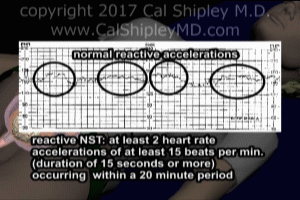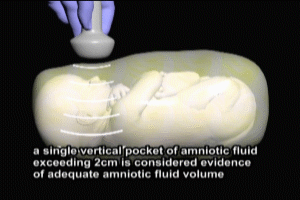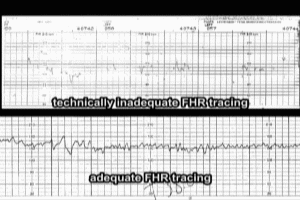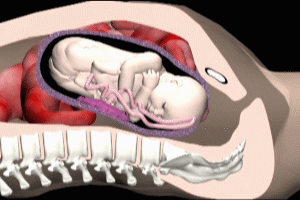Fetal Nontress Test OBS196
Fetal Nonstress Test Transcript
Fetal Nonstress Test
This is Dr. Cal Shipley with a review of the nonstress test.
Basis for the Fetal Nonstress Test
The basis of the nonstress test is that in a well oxygenated ,non acidemic fetus, the fetal heart rate will periodically undergo acceleration. Typically, these accelerations in fetal heart rate occur as a reaction to fetal movement within the uterus, and hence, a normal non-stress test is termed reactive.
Movement related fetal heart rate accelerations have a neurological basis. By 26 to 28 weeks of gestation, fetal neurological development enables movement related FHR accelerations to be detected. For this reason, the use of the non-stress test is limited to the third and final trimester of pregnancy.
Indications for the Fetal Nonstress Test
Use of the nonstress test is indicated in any pregnancy which has reached 26 to 28 weeks gestation where there is concern that the fetus is at increased risk of death. Here is a partial list of risk factors that may prompt assessment by a nonstress test
Typically, testing is performed weekly, but this frequency may be increased or decreased depending on changes in the maternal fetal status.
The nonstress test is commonly performed in conjunction with a biophysical profile. Click here to view my presentation on the Biophysical Profile.
One of the beauties of the nonstress test is that it is completely noninvasive and carries no risk whatsoever to either the mother or the fetus.
Nonstress Test Technique
Now let’s take a look at how the nonstress test is performed and interpreted. Monitoring of the fetal heart rate during the non-stress test is achieved by using an external heart rate monitor. The monitor’s sensor is attached to the mother’s abdomen via a strap as shown here.
“Reactive” Nonstress Test
The non-stress test is said to be normal, that is, reactive, if at least two heart rate accelerations of at least 50 beats per minute with duration of 15 seconds or more occur within a 20-minute period.
In the sample FHR strip shown here, there are four accelerations which fit the definition for the reactive NST occurring within about a seven-minute period.
Fetal Heart Rate (FHR) Accelerations
Now let’s take a closer look at one of these accelerations. The distance between each of the vertical lines on the FHR represents a ten second interval, while the space between horizontal lines represents a difference of 10 beats per minute in the fetal heart rate. With that knowledge in hand, let’s take a look at this particular acceleration and see if it meets our criteria for a reactive NST. The first thing we have to do is identify the baseline heart rate, that is, the fetal heart rate just prior to the acceleration. In this case, the baseline rate would be indicated by the arrow very close to 150 beats per minute. The peak of the acceleration corresponds to somewhere between 165 and 170 beats per minute. Let’s call it 165 beats per minute just to be on the safe side. Subtracting the baseline heart rate from the acceleration peak heart rate yields an acceleration of 15 beats per minute. Turning now to the duration of the acceleration, and again we’ll be somewhat conservative on this estimate to be on the safe side, we see a duration of about two and a half lines equivalent to 25 seconds. In summary, we have an acceleration of 15 beats per minute lasting a duration of about 25 seconds. This acceleration then does fit the definition of an acceleration seen in a reactive NST, an acceleration of at least 15 beats per minute with a duration of at least 15 seconds.
Nonreactive Fetal Nonstress Test
A nonreactive NST is one in which the previously specified heart rate accelerations do not occur. If reactivity is not noted during the first 20 minutes of the test, it is recommended that the fetal heart rate be monitored for an additional 20 minutes. Extending the test to a total of 40 minutes reduces the chance that quiet fetal sleep, one benign cause of non-reactivity, may be eliminated. Fetal sleep cycles typically do not last longer than 40 minutes.
It has been estimated that approximately half of non-reactive, non-stress tests are in fact false positives, that is, they occur in situations where the fetus is not actually compromised, and labor and delivery occur without incident. For this reason, a non-reactive NST should always be followed up promptly by additional testing, most commonly, the biophysical profile.
Finally, maternal cigarette smoking is a well-documented cause of false positive non-reactive NSTs, as is maternal ingestion of certain classes of drugs. If possible, cigarette smoking and drugs, which may affect the validity of the test, should be discontinued several days prior to testing.
Cal Shipley M.D., copyright 2020




